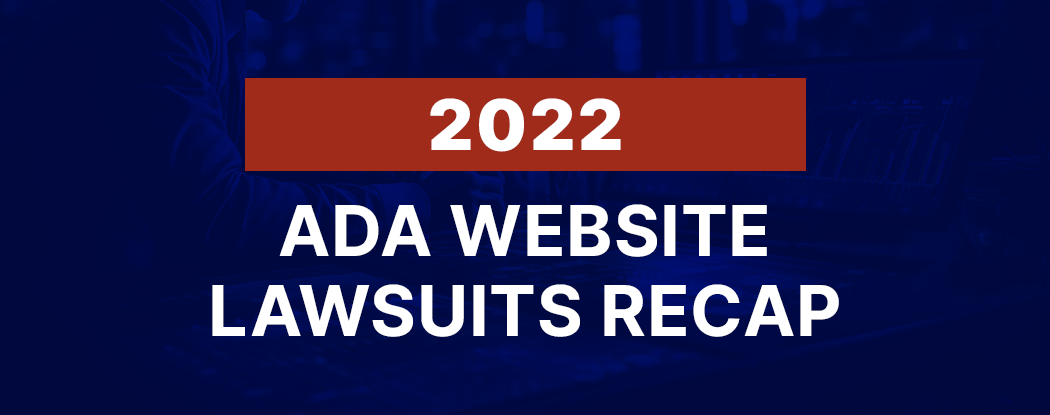- Digital Accessibility: A Right, Not a Privilege
In today’s connected world, digital accessibility is more than a buzzword; it’s a fundamental right. People with disabilities deserve the same opportunities to engage, shop, learn, and communicate online as everyone else. The ADA’s guidelines are not just legal mandates but are a call for digital inclusivity.
- 2022: A Year of Reckoning for Web Accessibility
The ADA Website Lawsuits Report 2022 paints a telling picture. The past year has witnessed a spike in ADA-related website lawsuits, signaling that many businesses have fallen short in ensuring their sites are accessible. This trend is a clarion call for introspection and action.
- Highlights from the 2022 Report
Delving into EcomBack’s comprehensive ADA Website Lawsuits Report 2022, we find:
- Industry Vulnerabilities: Some industries, notably retail and finance, have borne the brunt of these lawsuits more than others.
- Regional Patterns: While the issue is nationwide, certain states have become hotspots for these legal challenges.
- Recurring Barriers: The report sheds light on common accessibility barriers, offering a roadmap for businesses to address them.
- The Ripple Effect on Businesses
Beyond the legal ramifications, ADA non-compliance has profound business consequences:
· 1. Brand Equity:
In today’s hyper-connected digital landscape, the reputation and standing of a brand are more vulnerable than ever before. News of a lawsuit, particularly one related to web accessibility issues, can spread like wildfire through social media, news outlets, and online communities. The consequences of such negative publicity can be far-reaching and devastating for a company.
When a brand is embroiled in a web accessibility lawsuit, it often faces a severe hit to its brand equity. Customers and potential clients may question the company’s commitment to inclusivity and equal access for all. This can result in a loss of trust, loyalty, and credibility. Moreover, the negative association with a lawsuit can linger in the minds of consumers long after the legal proceedings have concluded.
In essence, brand equity is not merely about financial assets or market share; it’s also about intangible qualities like trust, reputation, and public perception. Web accessibility lawsuits have the potential to erode these intangibles rapidly, underscoring the critical importance of ensuring that your digital presence is fully compliant with accessibility standards.
2. Economic Impact:
Beyond the immediate legal penalties and settlements that may arise from web accessibility lawsuits, there are often substantial economic repercussions to consider. One of the most significant financial burdens stems from the need to redesign and rectify non-compliant websites.
Redesigning a website to meet accessibility standards can be a complex and resource-intensive endeavor. It requires hiring skilled web developers, designers, and accessibility experts, all of whom demand compensation for their services. Additionally, the process may involve significant revisions to the existing website’s structure, codebase, and content, which can lead to substantial costs in terms of time and resources.
Moreover, during the period of website redesign and rectification, there may be interruptions in normal online operations. This can result in lost business opportunities, decreased online traffic, and reduced revenue. For e-commerce businesses, in particular, these economic impacts can be felt acutely, as inaccessible websites can drive away potential customers and erode the trust of existing ones.
In essence, the economic impact of web accessibility issues extends far beyond the scope of legal penalties. It encompasses the direct costs of website remediation, as well as the indirect costs associated with lost business opportunities and customer trust.
3. Missed Market Segment:
Web accessibility is not just a matter of legal compliance; it’s also a matter of inclusivity and good business sense. Failing to ensure that your website is accessible alienates a substantial and diverse audience segment, resulting in missed revenue opportunities.
People with disabilities make up a significant portion of the global population, and they are also consumers with purchasing power. When your website is inaccessible, you effectively close the digital door on this demographic, denying them the opportunity to engage with your brand, products, and services. This exclusion not only limits your customer base but also sends a message of disregard for inclusivity and equal access.
Furthermore, web accessibility extends beyond just accommodating individuals with disabilities. It encompasses a broader range of user needs, including those with slow internet connections, older devices, or unique browsing preferences. By neglecting web accessibility, you risk alienating not only people with disabilities but also a broader spectrum of potential customers.
- Charting the Path to Compliance
Promoting Digital Inclusivity in Business:
In today’s increasingly digital world, ensuring accessibility for all users is not just a legal requirement but also a moral imperative. To foster digital inclusivity, businesses must take proactive measures:
1. Ongoing Assessments: Regularly evaluating your website’s accessibility is the first step towards creating an inclusive online environment. Conduct thorough assessments to identify potential issues and barriers that may prevent individuals with disabilities from accessing your digital content. These assessments should encompass a wide range of disabilities, including visual, auditory, motor, and cognitive impairments.
2. Educate and Empower: Building a culture of accessibility within your organization is crucial. Educate your team about the importance of digital inclusivity and provide them with the knowledge and tools needed to maintain compliance with the Americans with Disabilities Act (ADA) and other relevant accessibility standards. This might include training sessions, workshops, or online resources to ensure that everyone understands their role in creating an accessible digital space.
3. Seek Expertise: Accessibility is a complex field that requires specialized knowledge. To ensure that your digital platforms are truly inclusive, consider collaborating with accessibility professionals or consultants. These experts can provide valuable insights, conduct in-depth audits, and offer guidance on implementing necessary changes. Their expertise can help you navigate the intricacies of accessibility standards and regulations effectively.
4. User Testing and Feedback: Engage individuals with disabilities in user testing and gather their feedback. This firsthand input can be invaluable in identifying accessibility barriers and fine-tuning your digital offerings. By involving users with disabilities in the design and testing phases, you can create a more user-friendly and inclusive experience.
5. Continuous Improvement: Accessibility is an ongoing process, not a one-time task. Regularly review and update your digital assets to ensure they remain accessible as technology evolves and standards change. This might involve revisiting your website’s design, content structure, and functionality to keep up with best practices.
6. Transparency and Communication: Be transparent about your commitment to digital inclusivity. Share your accessibility efforts and progress with your audience, customers, and stakeholders. Effective communication can demonstrate your dedication to inclusivity and encourage feedback from users, helping you refine your accessibility initiatives further.
7. Legal Compliance: Keep abreast of the latest legal requirements and guidelines related to digital accessibility, such as the ADA and Web Content Accessibility Guidelines (WCAG). Ensure that your digital properties comply with these standards to avoid legal repercussions and, more importantly, to create an accessible environment for all users.
8. Inclusivity as a Competitive Advantage: Recognize that digital inclusivity isn’t just about compliance; it’s also a strategic advantage. An inclusive online presence can expand your customer base, improve user satisfaction, and enhance your brand’s reputation as a socially responsible and customer-centric organization.
- EcomBack: Championing Digital Inclusion
Through initiatives like the ADA Website Lawsuits Report 2022, EcomBack underscores its dedication to a universally accessible internet. By spotlighting challenges and offering actionable solutions, EcomBack is shaping a more inclusive digital future.
- Final Thoughts: Embracing an Inclusive Digital Future
The uptick in ADA website lawsuits in 2022 is more than a statistic; it’s a call to action. In a world that’s increasingly digital, businesses must champion accessibility, ensuring everyone can partake in the digital revolution.





